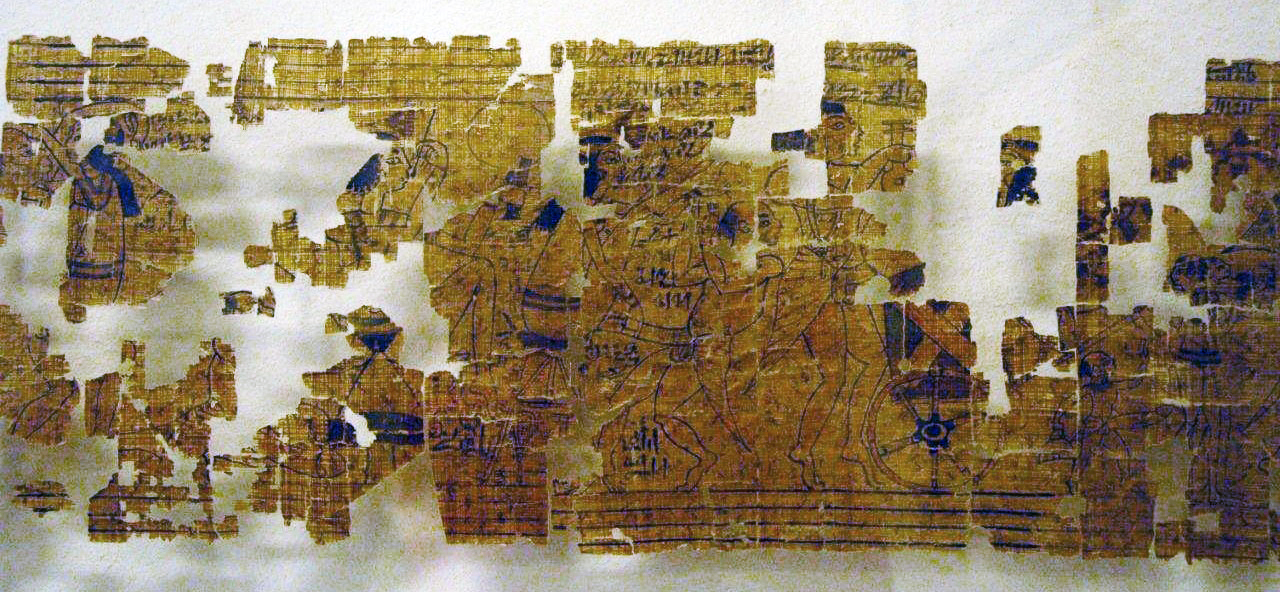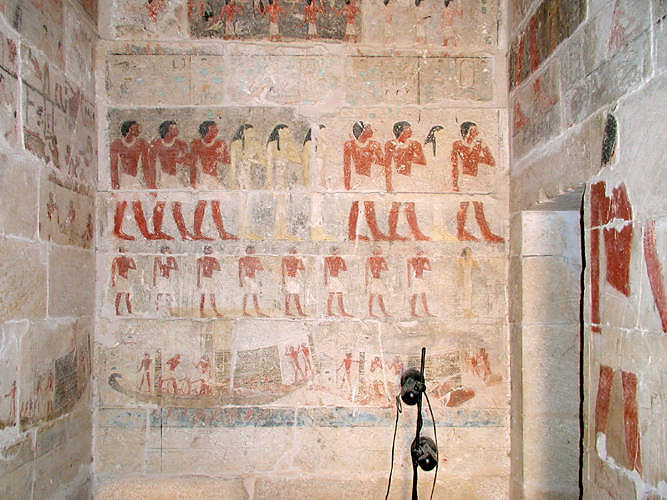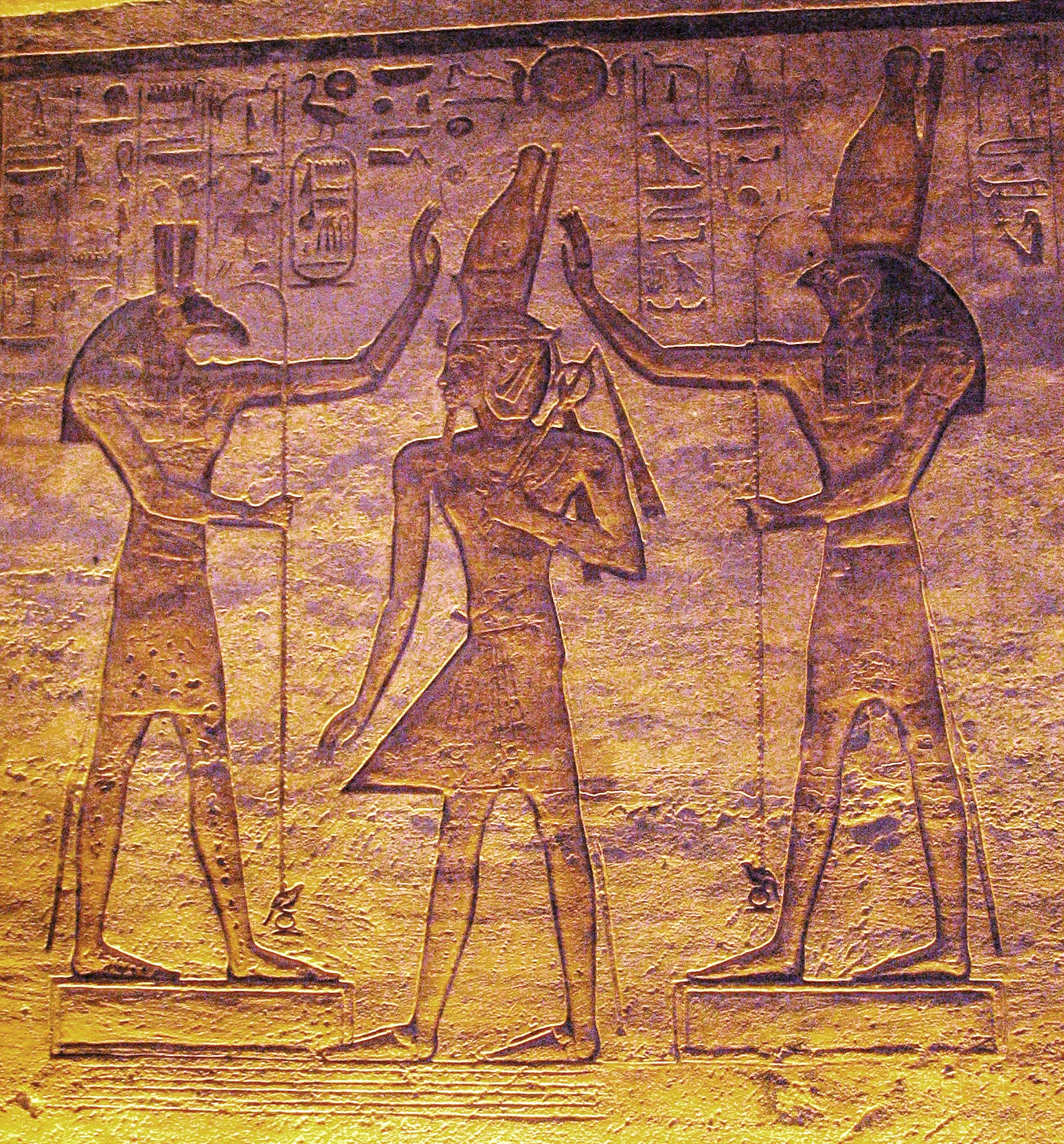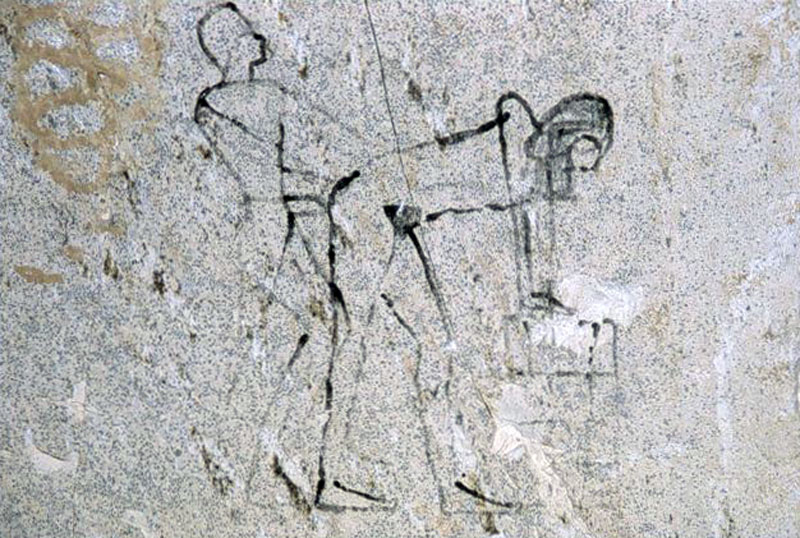Set and Horus adoring Ramesses (source)
Your post was very interesting and included a lot of information regarding the sexuality of Ancient Egyptians. Last semester I took the History of Sexuality and would recommend it to anyone interested in society, science, or gender. In the class we covered large portions of history in Europe and the US but we did not cover Ancient Egypt so I was excited to read your post. You mentioned that it is necessary to be cautious when thinking about sexuality, as it was not thought of the same way throughout time and space. In the west, we have a very dichotomous view of sexuality, though it is seems to be becoming easier for our society to accept bisexuality. I believe that sexuality has cultural and social components. The example of Ancient Egyptians and Greeks engaging in homosexual behavior is an example of this. Were these men gay because the engaged in homosexual acts? Possibly, but whether they were or not it was acceptable to engage in these acts due to their culture. I also thought that incest in Ancient Egypt is very interesting. It is such a taboo in so many cultures, so I wonder why it was acceptable for so many royals to engage in it? Maybe because they were seen as partially divine?
As to whether or not two women could be stigmatized for being in a relationship, it is unknown. There are some readings ofNephthys being a lesbiandue to her infertility and the ambiguous sexual orientation of her husband. While I am not sold on Nephthys being a lesbianthough she and Isis had a close enough relationship I can certainly believe itI would think that female homosexuality would likely not be seen as strange or as a threat.
As for art showing humans in sexually explicit positions, there is the famous example of graffiti of a pharaoh and a man commonly thought to be Hatshepsut and Senenmut. It would have been highly taboo to draw the queen in this manner.
Proudly powered by WordPress.Theme: Bushwick byJames Dinsdale.
If you made it this far, congratulations! Side note: the myth of Horus and Seth is one of the funniest things to me. I need an Egyptian mythology sitcom about these two.
Sexuality in Ancient Egypt is a subject to be approached with caution. Norms in regard to sexual behavior cannot be looked at with our Western understanding of sexual identity as many cultures, both past and present, do not create categories based on the same things we do. Moreover, we must be careful when interpreting both written and artistic accounts of sex as we might cast our own assumptions and biasessuch our inclination to ascribe to individuals monosexual identitiesonto those who dont fit into our mutually exclusive sexuality boxes.

This is one of the most interesting pieces of information I have read! It was a long post, and definitely worth the time. I am surprised that so much information was found on such a wealth of sexual information. I came into this post with an open mind. I did not want to pass judgement or try to explain their ways of life through the eyes of a modern day westerner.
The first thing that I found interesting is that bestiality was engaged in often but was highly illegal, yet the depictions of sexual contact on walls and papyrus was usually between a person and an animal. I did however, find the idea of necrophilia a little disturbing. I realize that according to their myths Isis had sex with Osiris after he had been torn apart and put back together again and this is how she conceived Horusbut it makes me wonder how it transferred over into real life. Did people expect to conceive if they repeated her actions? It is a little weird that they held onto dead bodies for a few days sometimes to make sure people would not copulate with the deceased.
Many deities wed their siblings in Egyptian mythology: She and Tefnut; Geb and Nut; Osiris and Isis; Seth and Nephthys. Egyptian royalty copied this pattern;King Tutunkhamens parents, for example, were siblings. This culminated a family line of inbreeding that caused the family to suffer from many malformations, infections and genetic diseases. However,there is little evidenceindicating that the common masses frequently married their siblings. Premarital sex between two siblings was strange, but it was not considered taboo.
The theory of them being siblings is a weird heteronormative approach to this relationship that quite honestly is baffling to the mind: they could not be lovers because their wives and children are depicted on their tombs walls. This is not an adequate response. First, lets break it down: behavior does not equal orientation. Because it was important to have children to care for their cult after death, their wives may have only served as a means to an end. As much as they loved one another, Niankhkhnum and Khnumhotep could not reproduce together, necessitating them to find wives to fulfill this purpose. However, this is under the biphobic suggestion that these two menmustbe monosexual. Both could have been attracted to multiple genders or sexes, and so may have had a romantic and/or sexual attachment to their wivesandeach other.
Your blog mentions bestiality being something that occurred in Ancient Egypt, we can also see this in other cultures such as Poseidon cursing a woman to fall in love with a bull, mating with it, and creating the Minotaur.
Scene from inside Niankhkhnum and Khnumhoteps mastaba (source)

A more than likely fictional tale from either the 18th, the 19th or the 25th dynasty, Neferkare was a pharaoh and Sasenet was one of his generals.The story goesthat a man named Tjeti saw Neferkare walking somewhere during the night and decided to follow him. The pharaoh went to Sasenets house, where he stayed for quite some time in the embrace of his lover before returning to his home. This process would then repeat itself.This tale alludes to the relationship between Osiris and Ra, the later rising to fulfill his duties as a sun deity at the end of their nightly embrace. It is a parody piece of that myth, and is useful in determining that, given the tone, homosexual relations at this point in time were scandalous, but were not so taboo as to be unmentionable.
Marriage is, of course, no evidence for a lack of homosexual activities or inclinations, but it is an indication of the prevailing social attitudes.

Cover image of Niankhkhnum and Khnumhotep (source)

When Egyptologists first uncovered the tomb ofNiankhkhnum and Khnumhotepat Sa电话ara, they were shocked to see that these two men not only shared a tomb, but that there was also art work depicted them in close, very intimate poses. Rather than believing that they were in a romantic and/or sexual relationship, the theory was immediately proposed that these two were merely brothersnothing else. Some have even gone so far as assert that Niankhkhnum and Khnumhotep were conjoined twins to explain why they are touching so often in artwork. They are depicted embracing in the same manner as heterosexual couples, which carries the same connotations of closeness in the context of sexual relations.This has spawned a very intense debate.

Homosexuality appears to be a common theme for both men and women. Although there seems to be much more proof of men partaking in these activities than women. Pictures of men in both positions, where women were merely assumed to be a lesbian or have lesbian tendencies when she was unable to conceive. Quite interesting! I will definitely be reading the links you embedded in the text!
I thoroughly enjoyed reading your blog this week. It is obvious you put a lot of time and research into it and the information was well organized, informative, and extremely interesting. I found the information on homosexuality in Ancient Egypt to be interesting. It is said that in Ancient Greece, there was no concept equivalent to the modern conception of sexual preference; it was assumed that a person would have both hetero- and homosexual responses at different times. Even other ancient pantheons of Gods seemed to explore an open sexuality. I agree with your statement that trying to make heterosexuality fit while ignoring evidence seems to go against the core of what scientific research is about.
In art, sex is not usually explicitly detailed, though since much artwork was either in tombs or temples it can be argued that their sexual acts were not depicted so as to avoid their desecration. That is not to say that the ancient Egyptians never drew graphic pictures; often, at least one party was drawn as an animal to censor the act as the Egyptians had a certain prudishness towards illustrations of sex between two humans. Beyond this, the Ancient Egyptians did not seem to be terribly shy about sex. Their mythology relies heavily on sexual themes, and there are many (possible) coded messages and euphemisms about sex riddled within the art itself. For example,King Tutankhamen is shown on a chest using a bowwhile his wife stands by his feet with an arrow at the ready; the verb to shoot in the Ancient Egyptian language also means to ejaculate. This is symbolic of the need to have sex in order to be reborn after death. Moreover, their religion itself was stepped in sexual themes, including the ithyphallic god Min.
There was apparentlyno concept of virginityor any sort of expectation for it. Individuals could freely pursue sexual relationships so long as both parties were unattached.
The Ancient Egyptians have ahistory of using birth control; different methods can be found in theKahun Gynecological Papyrus. One form of contraception included the use of acacia gum, about which it has since been learned that when compounded it essentially becomes spermicide. Various other substances were used inside of the vagina, including pessary made of crocodile dung.
While the subject of necrophilia is disturbing, I do wonder if it played a part in another other cultures. It has always seemed to me that the focus of death and the afterlife was more important in Egyptian culture than any other.
Adultery was highly tabooin Ancient Egyptian society with both men and women punished for this act. Emasculation for a man may have been a punishment for the rape of a married woman while consensual sex would result in both people being punished by whipping or mutilation, possibly even put to death. This is in the context of pursuing a relationship with a married woman, somale extramarital affairs with unmarried womendid not reflect badly on his character in the same way it did with a married woman or on cheating wives. However, men were not granted a free pass: it has been recorded thatin some communities cheating husbandswould experience social stigma for their actions.
In Egyptian mythology, Seth murdered and dismembered Osiris, necessitating Isis and Nephthys to collect the pieces. They were able to recover every part of Osiris except for his penis, so Isis created a new phallus for him. Restored, Isis has sex with her husband and thus conceives Horus. This helped to create the belief thateven after death a person still had sexual power, which if unspent could wreak havoc. Herodotus wrote that some corpses would not be delivered to the embalmers for several days to prevent them from copulating with the deceased.
The Ancient Egyptians apparently engaged in bestiality often, from cows to dogs to even crocodiles. This practice was illegal and carried high penalties, but amazingly people continued to practice it anyway.
Seth and Horus have had a long history of one-upsmanshipand some pretty awkward sexual tension. Seth, who has long wanted to be the chief god of the pantheon,tries to assert his dominance over Horus by having sex with him, planning to have penetrative or intercrural sex with Horus. By putting Horus in the womanly or passive position, Seth would have elicited the anger of the other gods towards Horus. This does not come to pass, however, thanks to aid of Isis who helps her son keep Seths semen off his body and plots to turn the tables around, making Seth appear to be the receptive partner by tricking him into eating Horuss semen. (Though,some sources saythat both men were equals in the sense that they were able to penetrate one another.) What can be gleaned from this story is that it was not homosexual relations themselves that were looked upon negatively but,like in Ancient Greece, the partner in the passive role who was disdained.

You must belogged into post a comment.
(Edit 10/26/14: Didnt finish my thought on lesbianism!)
Less crudely made, the infamous Turin Erotic Papyrus shows scenes of either animals or humans in various sexual acts and positions.Some consider it to bea satire on human manners and desires, as the animal vignettes on the first third of the papyrus suggest, which also mocks individuals of the upper class. Others consider it to be purely pornographic and that it was used as such.
I think it was great how much time you put into your article! It was obviously something you cared a lot about and the video links and heading were awesome and very helpful! I, too, thought it was surprising how they did not hold much worth on virginity seeing how it had a strong hold in Central and South American around the same time period (or a little later) and would continue to hold a lot of power for a long time after that! It still means a lot today! Another thing that shocked me was how laid back they were regarding other sexualities. They didnt necessarily give the go ahead for people to be in a homosexual or lesbian relationship per se, but they did not persecute them as would be seen all throughout the Middle Ages until quite recently. In their mythology, even the gods experienced/dealt with homosexual sexual tension and situations.
This was a great blog, lots of information and very interesting. I especially enjoyed the video links you set up. I was surprised to read that Egyptians did not really have a concept of virginity as well. As previously commented, most other societies we now of mention virginity in some way. I really enjoyed the myths of the gods also. Their behavior often goes against the western ideas of how a god acts. The stories of these gods are filled with jealousies, trickery and lewd actions. It makes these all powerful beings very human-like and almost more approachable or relatable in a way. Did the ancient Egyptians fear these gods?
I thought it was great how they were some of the first to practice birth control as well. It was interesting that they were proactive and knew different remedies to act as spermicides even back then and even in their harsh environment. Also, I agree with the way that they had a very low tolerance for adultery, though its not surprising that men were not treated as severely as women.
One creation myth details how the first god (Atum or Ra), who created himself, fathered the next generation of deities through masturbation. There was supposedlyan event in which the Pharaoh would ceremoniously ejaculate into the Nileto mimic Atum/Ras creation of Shu and Tefnut; that is, it was to encourage the fertility of the Nile. (I say this in a skeptical manner as I cannot find a corroborating article, merely ones that reference this claim.) On the Turin Erotic Papyrusone can see a woman seated on a vase to pleasure herselfwhile it is believed thatCleopatra may have created a vibratorfor herself using bees.
I found it interesting that virginity in Ancient Egypt held no significance. When we look at the Ancient American cultures like the Aztec where it is believed virginity and sacrifice was connected, it may show the difference of how separated cultures evolved.